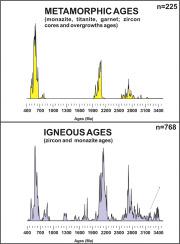当前位置:
X-MOL 学术
›
Gondwana Res.
›
论文详情
Our official English website, www.x-mol.net, welcomes your
feedback! (Note: you will need to create a separate account there.)
Significance of age periodicity in the continental crust record: The São Francisco Craton and adjacent Neoproterozoic orogens as a case study
Gondwana Research ( IF 7.2 ) Pub Date : 2020-10-01 , DOI: 10.1016/j.gr.2020.05.010 Rodrigo S. Marimon , Rudolph A.J. Trouw , Elton L. Dantas
Gondwana Research ( IF 7.2 ) Pub Date : 2020-10-01 , DOI: 10.1016/j.gr.2020.05.010 Rodrigo S. Marimon , Rudolph A.J. Trouw , Elton L. Dantas

|
Abstract The Sao Francisco Craton, in Brazil, together with adjacent orogenic systems formed during Gondwana assemblage, are well-suited for the study of crustal growth processes. The region's geological history is marked by a series of complete tectono-metamorphic cycles, from the Archean to late Neoproterozoic, comprising arc-related magmatism followed by continental collisions and ultimately post-tectonic igneous events and rifting. In this contribution, a comprehensive isotopic database was compiled from the literature, composed mainly of high-quality U-Pb magmatic and metamorphic ages (ca. 1000), together with Lu-Hf (ca. 1300) and Sm-Nd (ca. 300) data. Using this database, combined with a tectonic/geochemical synthesized review of the region, it is possible to test which of the available contending models can better explain the apparent periodicity in the formation of the continental crustal. Some interpreted the peaks and troughs in the crustal age record as periods of increased magmatic production, controlled by periodic mantellic events. Another hypothesis is that subduction-related rocks are shielded from tectonic erosion after continental amalgamation, the peaks thus reflecting enhanced preservation potential. The latter hypothesis is favored, as the variability regarding the timing of arc-related peak magmatic production (U-Pb age peaks) from different tectonic provinces around the globe and in the considered regions, coupled to the fact that peak arc-production is always closely followed in time by major continental amalgamations (supercontinent formation), precludes a unified global causation effect, such as mantellic overturns or slab avalanches, and supports the preservation bias hypothesis. Furthermore, the worldwide (including the Sao Francisco Craton) occurrence of plume-related magmatism is concentrated during the periods of supercontinent break-up (i.e. after major collisions), which better relates to a top-down control on mantle convection and opposes most of the models that advocate for the primary periodicity of magmatic production, which predict enhanced plume activity slightly prior or concomitant to supercontinent formation events.
中文翻译:

大陆地壳记录中年龄周期性的意义:以圣弗朗西斯科克拉通和邻近的新元古代造山带为例
摘要 巴西圣弗朗西斯科克拉通与冈瓦纳组合形成的相邻造山系统非常适合研究地壳生长过程。该地区的地质历史以一系列完整的构造-变质循环为标志,从太古代到晚新元古代,包括与弧相关的岩浆作用,随后是大陆碰撞,最终是后构造火成岩事件和裂谷。在这项贡献中,从文献中汇编了一个综合同位素数据库,主要由高质量的 U-Pb 岩浆和变质年龄(约 1000 年)以及 Lu-Hf(约 1300 年)和 Sm-Nd(约 1000 年)组成。 300) 数据。使用该数据库,结合对该地区的构造/地球化学综合审查,可以测试哪些可用的竞争模型可以更好地解释大陆地壳形成的明显周期性。一些人将地壳时代记录中的波峰和波谷解释为岩浆生产增加的时期,受周期性地幔事件控制。另一个假设是,与俯冲相关的岩石在大陆合并后免受构造侵蚀,因此山峰反映了增强的保存潜力。后一种假设是有利的,因为来自全球不同构造省份和所考虑区域的弧相关峰值岩浆生产(U-Pb 年龄峰值)时间的可变性,加上峰值弧生产总是紧随其后的是主要的大陆合并(超大陆形成),排除了统一的全球因果效应,例如地幔翻转或板块雪崩,并支持保存偏差假设。此外,世界范围内(包括圣弗朗西斯科克拉通)与羽流相关的岩浆活动集中在超大陆破裂时期(即大碰撞后),这与对地幔对流的自上而下控制更好地相关,并且反对大多数主张岩浆产生的主要周期性的模型,这些模型预测在超大陆形成事件之前或伴随着超大陆形成事件的增强的羽流活动。
更新日期:2020-10-01
中文翻译:

大陆地壳记录中年龄周期性的意义:以圣弗朗西斯科克拉通和邻近的新元古代造山带为例
摘要 巴西圣弗朗西斯科克拉通与冈瓦纳组合形成的相邻造山系统非常适合研究地壳生长过程。该地区的地质历史以一系列完整的构造-变质循环为标志,从太古代到晚新元古代,包括与弧相关的岩浆作用,随后是大陆碰撞,最终是后构造火成岩事件和裂谷。在这项贡献中,从文献中汇编了一个综合同位素数据库,主要由高质量的 U-Pb 岩浆和变质年龄(约 1000 年)以及 Lu-Hf(约 1300 年)和 Sm-Nd(约 1000 年)组成。 300) 数据。使用该数据库,结合对该地区的构造/地球化学综合审查,可以测试哪些可用的竞争模型可以更好地解释大陆地壳形成的明显周期性。一些人将地壳时代记录中的波峰和波谷解释为岩浆生产增加的时期,受周期性地幔事件控制。另一个假设是,与俯冲相关的岩石在大陆合并后免受构造侵蚀,因此山峰反映了增强的保存潜力。后一种假设是有利的,因为来自全球不同构造省份和所考虑区域的弧相关峰值岩浆生产(U-Pb 年龄峰值)时间的可变性,加上峰值弧生产总是紧随其后的是主要的大陆合并(超大陆形成),排除了统一的全球因果效应,例如地幔翻转或板块雪崩,并支持保存偏差假设。此外,世界范围内(包括圣弗朗西斯科克拉通)与羽流相关的岩浆活动集中在超大陆破裂时期(即大碰撞后),这与对地幔对流的自上而下控制更好地相关,并且反对大多数主张岩浆产生的主要周期性的模型,这些模型预测在超大陆形成事件之前或伴随着超大陆形成事件的增强的羽流活动。











































 京公网安备 11010802027423号
京公网安备 11010802027423号